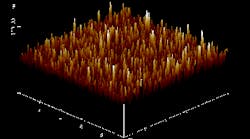A new reverse osmosis membrane for desalination resists clogging better than conventional membranes and so promises to significantly reduce operating costs, say its developers at the University of California, Los Angeles. The highly permeable surface-structured membrane can be easily retrofitted into commercial systems, add the researchers.
The membrane is made of a polyamide thin-film composite. An atmospheric pressure plasma creates active sites on its surface that then are used to initiate graft polymerization to create a "brush layer" of polymer chains anchored to the surface that are constantly in motion (Figure 1).
Figure 1. Both surface chemistry and topography of membrane can be tuned to achieve the desired level of performance.
Source: University of California, Los Angeles.
"Protein or bacteria need to be able to anchor to multiple spots on the membrane to attach themselves to the surface — a task which is extremely difficult to attain due to the constant motion of the brush layer. The polymer chains protect and screen the membrane surface underneath," explains Yoram Cohen, professor of chemical and biomolecular engineering in the school’s Henry Samueli School of Engineering and Applied Science and leader of the research team.
"Besides possessing high water permeability, the new membrane also shows high rejection characteristics and long-term stability," notes Nancy H. Lin, senior researcher and lead author of a paper on the development in the Journal of Materials Chemistry. "Structuring the membrane surface does not require a long reaction time, high reaction temperature or the use of a vacuum chamber."
"In terms of material chemical resistance the membranes should have the same life as commercial membranes. This is typically from three to seven years depending upon the application. However, with a lower frequency of cleaning cycles (due to greater fouling resistance), such membranes could have a longer lifetime," notes Cohen.
"Based on material and production cost, I would expect a price that is perhaps about 5% higher [than conventional membranes]; however, given the longer lifetime and lower cost of cleaning/replacement, the actual cost to the user could be significantly lower on the basis of total volume of water treated per membrane over the lifetime of the membrane," he says.
Field studies are underway with brackish water. The researchers are exploring options for producing larger size sheets of membrane.

